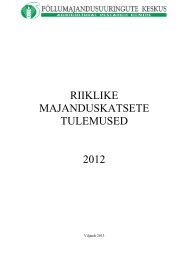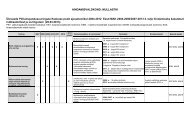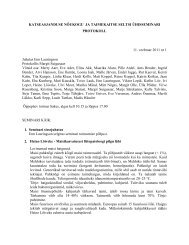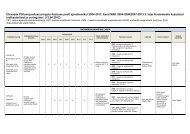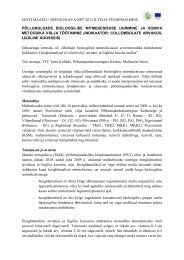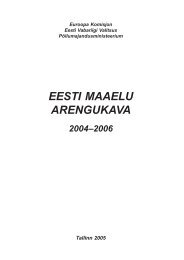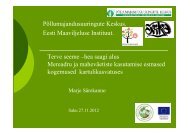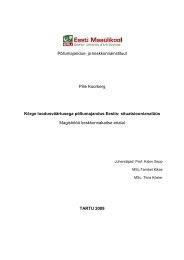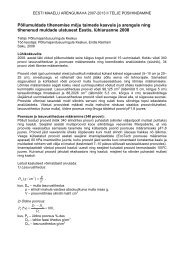Kasutatud uurimistööde aruanded:Aavik, T. 2005. Soontaimede liigirikkus ja koosseis Eesti põllumajandusmaastikel (magistritöö). TartuÜlikool.Aavik, T., Liira, J. 2008. Agrotolerant and high nature-value species - plant biodiversity indicatorgroups in agroecosystems (käsikiri ajakirja esitatud).Albrecht, H. ja Mattheis, A. 1998. The effects of organic and integrated farming on rare arable weedson the Forschungsverbund Agrarökosysteme München (FAM) research station in southern Bavaria.Biological Conservation. 86: 347-356.Aude, E., Tybirk, K. ja Bruus Pedersen, M. 2003. Vegetation diversity of conventional and organichedgerows in Denmark. - Agriculture, Ecosystems & Environment. 99: 135-147.Bouche M.B., 1977. Strategies lombriciennes. In: U.Lohm, T.Persson (Eds.) Soil.Organisms ascomponents of ecosystem. Ecol.Bull. (Stockholm), 25: 122-132.Donald, P.F., Pisano, G., Rayment, M.D., Pain, D.J., 2002. The Common Agricultural Policy, EUenlargement and the conservation of Europe`s farmland birds. Agriculture, Ecosystems andEnvironment. 89: 167–182.Donald, P.F., Sanderson, F.J., Burfield, I.J., van Bommel, F.P.J., <strong>2006</strong>. Further evidence ofcontinent-wide impacts of agricultural intensification on European farmland birds, 1990-2000.Agriculture, Ecosystems and Environment. 116: 189–196.Doube B.M., Schmidt O. 1997. Can the abundance or activity of soil macrofauna be used to indicatethe biological health of soils. In: Biological Indicators of soils health (Ed. By Pankhurst C.E., DoubeB.M., Cupta V.V.S.R.). CAB International, Wallingford, p.265-29.Edwards C.A., Bohlen P.J. 1996. Biology and Ecology of Earthworms. Chapman &Hall, London,1996, 426 pp.EEA (European Environment Agency), 2003. Europe’s environment: the third assessment.Environmental assessment report No 10, p. 344.Elts, J. 1997. Studies of the Corncrake in Estonia in 1995. Vogelwelt. 118: 236–238.Elts, J., 2003. Põllumajandus lindude pilgu läbi, 4 lk. (käsikiri)Elwell, H.A, Stocking, M.A, 1976. Vegetal cover to estimate soil erosion hazard in Rhodesia.Geoderma, 15, pp. 61-70.FAO, 2000. Soil and terrain database, soil degradation status and soil vulnerability assessment forcentral and Eastern Europe. FAO land and water digital media series.Fussell, M., Corbet, S. A., 1991. Forage for bumble bees and honey bees in farmland: a case study.– Journal. Apic. Res. 30: 87–97.Fussell, M., Corbet, S. A., 1992. Flower usage by bumble bees: a basis for forage plantmanagement. – Journaol of Application Ecology. 29: 451–465.Heikkinen, R.K., Luoto, M., Virkkala, R., Rainio, K., <strong>2004</strong>. Effects of habitat cover, landscapestructure and spatial variables on the abundance of birds in an agricultural-forest mosaic. Journal ofApplied Ecology. 41: 824-835.Herzon, I. 2007. Ode to a Skylark: Agricultural intensification and farmland birds in the Baltic region(Phd thesis). Yliopistopaino. Helsinki.Herzon, I., Aunins, A., Elts, J., Preiks, Z. 2008 Intensity of agricultural land-use and farmland birds inthe Baltic States. Agriculture, Ecosystems and Environment. 125: 93-100.Hole, D.G., Perkins, A.J., Wilson, J.D., Alexander, I.H., Grice, P.V. ja Evans, A.D. 2005. Doesorganic farming benefit biodiversity? Biological Conservation. 122: 113-130.234
IEEP, 2007. Guidance document to the Member States on the application of the HNV impactindicatorIvask, M, Truu, J., Sepp, K. 2001. Effect of agricultural management prctices on soil biota. In: IALEEuropean Conference. Development of European Landscapes. Conference Proceedings, Vol II(Mander, Ü., Printsmann, A., Palang, H., eds.). Publ. Instituti Geographici Un. Tartuensis, 92. Tartu,688-693.Ivask, M., Truu, J. 1997. Mullaelustiku näitajate rakendamine maa kasutusest tulenevate mõjudehindamisel. APS toimetised 4, 9-12.Johansen, C. A., Mayer, D. F., 1990. Pollinator protection: a bee and pesticide handbook. Wicwaspress, Cheshire, Connecticut, USA.Karise, R., Viik, E., Mänd, M. 2007. Impact of alpha-cypremethrin on honey bees foraging on springoilseed rape Brassica napus flowers in field conditions. Pest Management Science. 63: 1085-1089.Kask, R. 1996. Eesti mullad. Tallinn, 239 lk.Kask, R., 1955. Vee-erosioon Eesti NSV-s ja perspektiivid võitluses temaga. Autoreferaatpõllumajanduskandidaadi teaduskraadi taotlemiseks esitatud väitekirjast. Tallinn, 30 lk. (vene k).Kirkby, M.J., Morgan R., P.C., 1984. Erozija potshvy. Moskva, 415 lk.KKM info- ja tehnokeskus, Eesti veekasutuse aasataruanded <strong>2004</strong>-<strong>2006</strong> kohta, www.keskkonnainfo.eeKokk, R., 1995. Muldade jaotumus ja omadused. Rmt.-s A. Raukas (koost.) Eesti Loodus, Tallinn, lk430-439.Laasimer, 1965. Eesti NSV taimkate. Tallinn, 397 lk.Loid, H., 1985. Kultuurrohumaade osast kuppelalade viljakuse suurendamisel.Põllumajandusmaastiku ökoloogia ja ökonoomika. Tallinn-Võru, lk. 75-77.Mänd, M., Mänd, R., Williams, I.H. 2002. Bumblebees in the agricultural landscape of Estonia.Agriculture, Ecosystems and Environment. 89: 69-76.Narusk M., Soots N. <strong>2004</strong>. aasta Eesti veemajanduse ülevaade aruande VEEKASUTUS alusel.Keskkonnaministeeriumi info- ja tehnokeskus. Toimetis 05-1. Tallinn 2005.Pain, D., Pienkowski, M., 1997. Farming and Birds in Europe. The Common Agricultural Policy andits Implications for Bird Conservation. Academic Press. London. UK. 448 pp.Potts, G.R. 1986. The Partridge: Pesticides, Predation and Conservation. Collins. London.Ratas, R., 1977. Põllumajandusmaastikust ja kaitsepuistutest. Rmt.-s Põllumajandusmaastikuökoloogia küsimusi. Tln.Ratas, R., Int, L. 1978. Muld, ilm ja tuulekanne. Eesti Loodus 4. Tallinn, lk. 330-342.Schnürer J., Rosswall T. 1982. Fluorescein hydrolysis as a measure of total microbial activity in soiland litter. Appl. Env. Microbiol. 43: 1256-1261.Siriwardena., G. M., Baillie, S.R., Crick, H.Q.R., Wilson, J.D., 2000. The importance of variation inthe breeding performance of seed-eating birds in determining their population trends on farmland.Journal of Applied Ecology. 37: 128-148.Stenberg B. 1999. Monitoring Soil Quality of Arable Land: Microbiological Indicators. Acta Agric.Scand., Sect. B., Soil and Plant Sci. 49: 1-24.Timm T. 1999. Eesti rõngusside (Annelida) määraja. A Guide to the Estonian Annelida.Looduseuurija käsiraamatud 1. Eesti Loodusuurijate Seltsi väljaanne. Teaduste Akadeemia Kirjastus,Tartu-Tallinn, 208 lk.Truu M, Truu J, Ivask, M. 2008. Soil microbiological and biochemical properties for assessing theeffect of agricultural management practices in Estonian cultivated soils. European Journal of SoilBiology. 44: 231-237.235
- Page 1 and 2:
Põllumajandusuuringute KeskusEESTI
- Page 3 and 4:
4.1.4.2. Hindamiskriteerium VI.1.A-
- Page 5 and 6:
4.4. VALDKOND MAASTIK..............
- Page 7 and 8:
LÜHENDID JA MÕISTEDBA - biomassi
- Page 9 and 10:
kogutavad andmed), teostatakse ka s
- Page 11 and 12:
Finants- ja rakendamisalase info p
- Page 13 and 14:
2006. a uusi taotlusi baastegevusel
- Page 15 and 16:
Eritegevus (kohalikku ohustatud tõ
- Page 17 and 18:
vähendaks reostus- ja erosioonioht
- Page 19 and 20:
2. KOKKUVÕTE MAK PKT 2004-2006 RAK
- Page 21 and 22:
2.2.2. PKT areng 2004-2006MAK 2004-
- Page 23 and 24:
PKT taotlenud põllumajandustootjat
- Page 25 and 26:
Tulemused:Alates mahepõllumajandus
- Page 27 and 28:
Osalemistingimused ja nõuded:Toetu
- Page 29 and 30:
Tabel 4. PKT loodetava keskkonnamõ
- Page 31 and 32:
Tabel 6. MAK 2004-2006 põllumajand
- Page 33 and 34:
Tabel 8. Koondtabel toetuste taotle
- Page 35 and 36:
14090008000120100806040200HARJUMAAH
- Page 37 and 38:
MaakondÜPT (shPKT) (ha)KST (ha)KST
- Page 39 and 40:
hektarid (ha)450000400000350000Muud
- Page 41 and 42:
2.2.4.4. Viljavaheldusplaanis libli
- Page 43 and 44:
30252015105020042005200620072004200
- Page 45 and 46:
40353025%20HARJU MAAHIIUMAAIDA-VIRU
- Page 47 and 48:
3.2. ÜLEVAADE PKT HINDAMISEL KASUT
- Page 49 and 50:
VALDKOND VESIINDIKAATOR/UURINGIndik
- Page 51 and 52:
VALDKOND BIOLOOGILINE MITMEKESISUS
- Page 53 and 54:
VALDKOND SOTSIAALMAJANDUS JA MUU (j
- Page 55 and 56:
Hindamisküsimusele VI.2.C sobis va
- Page 57 and 58:
Deflatsiooni uuringu tulemusena lei
- Page 59 and 60:
Joonis 14. Uuritud valdade paiknemi
- Page 61 and 62:
0 25 50kmTallinnRakvereNarvaKärdla
- Page 63 and 64:
4.1.3. Indikaator: mullaviljakus4.1
- Page 65 and 66:
8,07,06,06,8 6,97,2 6,8 6,96,97,3 6
- Page 67 and 68:
8075706060536856%504030201019645391
- Page 69 and 70:
Suhteliselt vähe oli kaaliumivaese
- Page 71 and 72:
60%50%40%EestiTestmaakonnad30%20%10
- Page 73 and 74:
70%60%50%Corg-PKTCorg40%30%20%10%0%
- Page 75 and 76:
4.1.3.2.6.3. KaaliumKaaliumisisaldu
- Page 77 and 78:
Hindamisküsimustele vastamineKüsi
- Page 79 and 80:
põllukultuuride osatähtsus pisut
- Page 81 and 82:
Tuule-erosioon Eestis on oma kahjus
- Page 83 and 84:
4.1.4.4. Riigispetsiifiline hindami
- Page 85 and 86:
Väetiste kasutamine aruandeperiood
- Page 87 and 88:
504540J28 (MAHE)PLin (KST)35NO3 - ,
- Page 89 and 90:
4.2.3. Indikaator: toiteelementide
- Page 91 and 92:
45403530ÜPTKSTMAHEN kg/ha252015105
- Page 93 and 94:
Kokkuvõte:• Lämmastiku bilanss
- Page 95 and 96:
KST pm maa kohta KST töödeldud ma
- Page 97 and 98:
Hindamisküsimustele vastamineKüsi
- Page 99 and 100:
c) millest on kultuurid ja/või vil
- Page 101 and 102:
KST ettevõtetes olid uuritud taime
- Page 103 and 104:
4.3. VALDKOND BIOLOOGILINE MITMEKES
- Page 105 and 106:
nii põldude kui ka põlluservade t
- Page 107 and 108:
Seirepiirkonniti analüüsides, oli
- Page 109 and 110:
õitsevad looduslikud taimed, mida
- Page 111 and 112:
Tabel 16. PMK linnuseire üldparame
- Page 113 and 114:
Summaarne asustustihedus,p/10 ha151
- Page 115 and 116:
4.3.3.3. Linnustiku muutused erinev
- Page 117 and 118:
väheneva arvukusega alasid. See n
- Page 119 and 120:
Pruunselg-põõsalind kui tüüpili
- Page 121 and 122:
4.3.4. Indikaator: soontaimede koos
- Page 123 and 124:
Taimestiku liigiline koosseis põld
- Page 125 and 126:
Järgnevalt on välja toodud PKT vi
- Page 127 and 128:
4.3.5.3. Vihmaussikoosluse ökoloog
- Page 129 and 130:
2005. ja 2006. aastal aga mitte. 20
- Page 131 and 132:
aspektist lähtudes. Hindepunktide
- Page 133 and 134:
Hindamisküsimustele vastamineKüsi
- Page 135 and 136:
VI.2.B-3. Väärtuslikke märgalasi
- Page 137 and 138:
4.3.6.1.3. Programmi indikaator VI.
- Page 139 and 140:
Kui kõigi vihmausside ja mulla mik
- Page 141 and 142:
4.3.6.2.2.Programmi indikaator VI.2
- Page 143 and 144:
1412Kimalaseliikide arv10864200 2 4
- Page 145 and 146:
4,0Shannoni lindude mitmekesisuse i
- Page 147 and 148:
MAHE kui ÜPT põldudele. Kaudselt
- Page 149 and 150:
4.3.6.4. Riigispetsiifiline hindami
- Page 151 and 152:
sõltuvalt seirepiirkonnast selgus,
- Page 153 and 154:
Taimede ja maastikuelementide vahel
- Page 155 and 156:
õiguslikuna põllumajandusmaa, mil
- Page 157 and 158:
2005. aastal taotluste vastuvõtupe
- Page 159 and 160:
kiviaedu mujal kui ainult põllumaj
- Page 161 and 162:
4.3.8. Hindamisküsimus VI.2C. Mil
- Page 163 and 164:
Tabel 26. Kohalikku ohustatud tõug
- Page 165 and 166:
4.4. VALDKOND MAASTIK4.4.1. Valdkon
- Page 167 and 168:
4.4.2. Hindamisküsimus VI.3. Mil m
- Page 169 and 170:
Tabel 29. Maastikuseireruutude rohu
- Page 171 and 172:
VI.3-2.1 a) tänu visuaalsele keeru
- Page 173 and 174:
1,81,6SHDI indeks1,41,210,80,60,420
- Page 175 and 176:
Ohustatud tõugu loomade (eesti hob
- Page 177 and 178:
Kokkuvõte:• Keeruline on mõõta
- Page 179 and 180:
4.5. RIIGIOMANE VALDKOND SOTSIAALMA
- Page 181 and 182:
2007. aasta lõpu seisuga oli alla
- Page 183 and 184: Taimekasvatuse suhteliselt väike o
- Page 185 and 186: Kr / ha25002000150010005000-500-100
- Page 187 and 188: 3 0002 5002 000kr / ha1 5001 000500
- Page 189 and 190: 4.5.3. Indikaator: mahetoodanguna m
- Page 191 and 192: 10095 89888077%60402002003200420052
- Page 193 and 194: 4.5.4. Indikaator: keskkonnateadlik
- Page 195 and 196: Hindamisküsimustele vastamineKüsi
- Page 197 and 198: 4.5.6 Hindamisküsimus VI.4.B Mil m
- Page 199 and 200: 4.6. MAK MEETMEID LÄBIVAD HINDAMIS
- Page 201 and 202: Majanduslikult suuremad mahepõllum
- Page 203 and 204: 4.6.2. Läbiv hindamisküsimus 4. M
- Page 205 and 206: mahetoodete osa” analüüs FADN v
- Page 207 and 208: Koolitused on mänginud kindlasti v
- Page 209 and 210: hektarid (ha)450000400000350000Muud
- Page 211 and 212: 4.6.3.4. Hindamiskriteerium 5-4. Ma
- Page 213 and 214: (b) seotud püsikultuuridega (rohum
- Page 215 and 216: 5.2.1. Põllumajandusettevõtete ü
- Page 217 and 218: 5.2.1.3. Teraviljakasvatuse agroteh
- Page 219 and 220: 5.2.1.5. Mahe- ja tavataimekasvatus
- Page 221 and 222: 0.25Mikroobide biomass (mgC/g0.200.
- Page 223 and 224: 6. HINDAMISKÜSIMUSTEST JA PKT SEIR
- Page 225 and 226: mille jätkumine viib mullaviljakus
- Page 227 and 228: 6.1.4. Valdkond maastik• Põlluma
- Page 229 and 230: ja sellest lähtuvalt tulemuste par
- Page 231 and 232: Kui rohumaade ja püsikultuuride pi
- Page 233: VIITEALLIKAD (KASUTATUD KIRJANDUS)M
- Page 237 and 238: Linnuseire andmete täiendav analü
- Page 239: LISAD (eraldiseisev osa)LISA 1. ADM



